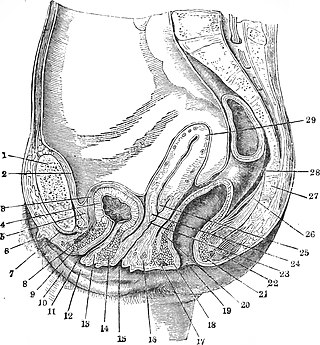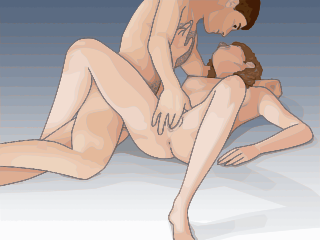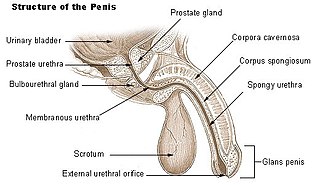Related Research Articles

Orgasm or sexual climax is the sudden discharge of accumulated sexual excitement during the sexual response cycle, resulting in rhythmic, involuntary muscular contractions in the pelvic region characterized by sexual pleasure. Experienced by males and females, orgasms are controlled by the involuntary or autonomic nervous system. They are usually associated with involuntary actions, including muscular spasms in multiple areas of the body, a general euphoric sensation and, frequently, body movements and vocalizations. The period after orgasm is typically a relaxing experience, attributed to the release of the neurohormones oxytocin and prolactin as well as endorphins.

The urethra is a tube that connects the urinary bladder to the urinary meatus for the removal of urine from the body of both females and males. In human females and other primates, the urethra connects to the urinary meatus above the vagina, whereas in marsupials, the female's urethra empties into the urogenital sinus.

The prostate is both an accessory gland of the male reproductive system and a muscle-driven mechanical switch between urination and ejaculation. It is found only in some mammals. It differs between species anatomically, chemically, and physiologically. Anatomically, the prostate is found below the bladder, with the urethra passing through it. It is described in gross anatomy as consisting of lobes and in microanatomy by zone. It is surrounded by an elastic, fibromuscular capsule and contains glandular tissue as well as connective tissue.

In female human anatomy, Skene's glands or the Skene glands are glands located around the lower end of the urethra. The glands are surrounded by tissue that swells with blood during sexual arousal, and secrete a fluid from openings near the urethra, particularly during orgasm.

The G-spot, also called the Gräfenberg spot, is characterized as an erogenous area of the vagina that, when stimulated, may lead to strong sexual arousal, powerful orgasms and potential female ejaculation. It is typically reported to be located 5–8 cm (2–3 in) up the front (anterior) vaginal wall between the vaginal opening and the urethra and is a sensitive area that may be part of the female prostate.

Female ejaculation is characterized as an expulsion of fluid from the Skene's gland at the lower end of the urethra during or before an orgasm. It is also known colloquially as squirting, although research indicates that female ejaculation and squirting are different phenomena, squirting being attributed to a sudden expulsion of liquid that partly comes from the bladder and contains urine.

Prostate massage is the massage or stimulation of the male prostate gland for medical purposes or sexual stimulation.

Retrograde ejaculation occurs when semen which would be ejaculated via the urethra is redirected to the urinary bladder. Normally, the sphincter of the bladder contracts before ejaculation, sealing the bladder, which, besides inhibiting the release of urine, also prevents a reflux of seminal fluids into it during ejaculation. The semen is forced to exit via the urethra, the path of least resistance. When the bladder sphincter does not function properly, retrograde ejaculation may occur. It can also be induced deliberately by a male as a primitive form of male birth control or as part of certain alternative medicine practices. The retrograde-ejaculated semen, which goes into the bladder, is excreted with the next urination.

An erogenous zone is an area of the human body that has heightened sensitivity, the stimulation of which may generate a sexual response, such as relaxation, sexual fantasies, sexual arousal and orgasm.

The ejaculatory ducts are paired structures in male anatomy. Each ejaculatory duct is formed by the union of the vas deferens with the duct of the seminal vesicle. They pass through the prostate, and open into the urethra above the seminal colliculus. During ejaculation, semen passes through the prostate gland, enters the urethra and exits the body via the urinary meatus.
Ernst Gräfenberg was a German-born physician and scientist. He is known for developing the intra-uterine device (IUD), and for his studies of the role of the woman's urethra in orgasm. The G-spot is named after him.

The urethral sponge is a spongy cushion of tissue, found in the lower genital area of females, that sits against both the pubic bone and vaginal wall, and surrounds the urethra.

Prostatectomy as a medical term refers to the surgical removal of all or part of the prostate gland. This operation is done for benign conditions that cause urinary retention, as well as for prostate cancer and for other cancers of the pelvis.

Fingering is typically the use of fingers or hands to sexually stimulate the vulva or vagina. Vaginal fingering is legally and medically called digital penetration or digital penetration of the vagina. Fingering may also include the use of fingers to sexually stimulate the anus.

The urinary meatus, also known as the external urethral orifice, is the opening of the urethra. It is the point where urine exits the urethra in both sexes and where semen exits the urethra in males. The meatus has varying degrees of sensitivity to touch. The meatus is located on the glans of the penis or in the vulval vestibule.

The urethral sphincters are two muscles used to control the exit of urine in the urinary bladder through the urethra. The two muscles are either the male or female external urethral sphincter and the internal urethral sphincter. When either of these muscles contracts, the urethra is sealed shut.
Human sexuality is the way people experience and express themselves sexually. This involves biological, psychological, physical, erotic, emotional, social, or spiritual feelings and behaviors. Because it is a broad term, which has varied with historical contexts over time, it lacks a precise definition. The biological and physical aspects of sexuality largely concern the human reproductive functions, including the human sexual response cycle.
The G Spot and Other Recent Discoveries About Human Sexuality is a book by Alice Kahn Ladas, Beverly Whipple, and John D. Perry that argues for the existence of the Gräfenberg Spot and popularized the term G-Spot. It was published in 1982 and became an international bestseller, appearing on The New York Times bestseller list, and was translated into 19 languages. The book was published by Holt, Rinehart, and Winston and was, at the suggestion of Ladas, a popular account of three academic papers published by the authors the previous year.

Ejaculation is the discharge of semen from the male reproductory tract as a result of an orgasm. It is the final stage and natural objective of male sexual stimulation, and an essential component of natural conception. In rare cases, ejaculation occurs because of prostatic disease. Ejaculation may also occur spontaneously during sleep. Anejaculation is the condition of being unable to ejaculate. Ejaculation is usually very pleasurable for men; dysejaculation is an ejaculation that is painful or uncomfortable. Retrograde ejaculation is the condition where semen travels backwards into the bladder rather than out the urethra.

Beverly Whipple is Professor Emerita at Rutgers University and a professional author and sexologist. She is a co-author of the publication The G Spot and Other Recent Discoveries About Human Sexuality.
References
- ↑ Gary Schubach (August 2001). "Urethral Expulsions During Sensual Arousal and Bladder Catheterization in Seven Human Females". Electronic Journal of Human Sexuality. 4.
- ↑ Simon, LeVay (2006). Human sexuality. Sinauer Associates. p. 81. ISBN 9780878934652.
- ↑ Judith, Kuriansky (2002). The Complete Idiot's Guide to Tantric Sex. Penguin Group. p. 180. ISBN 9781569756256.
- ↑ Pokras, Somraj (2007). Male Multiple Orgasm. Amorata Press. p. 179. ISBN 978-1-56975-625-6.
- ↑ Schubach, Gary (20 September 2011). "The Human Female Prostate and Its Relationship to the Popularized Term, G-Spo".
- ↑ Schubach, Gary (April 2002). "The G-spot is the female prostate". American Journal of Obstetrics and Gynecology. 186 (4): 850. doi: 10.1067/mob.2002.121628 . PMID 11967519.
- ↑ Ernest Gräfenberg (1950). "The role of urethra in female orgasm". International Journal of Sexology. 3 (3): 145–148.
- ↑ Schubach, Gary. "New Study Confirms Doctor G's Conclusions About Female Ejaculation". Archived from the original on 2012-04-27.